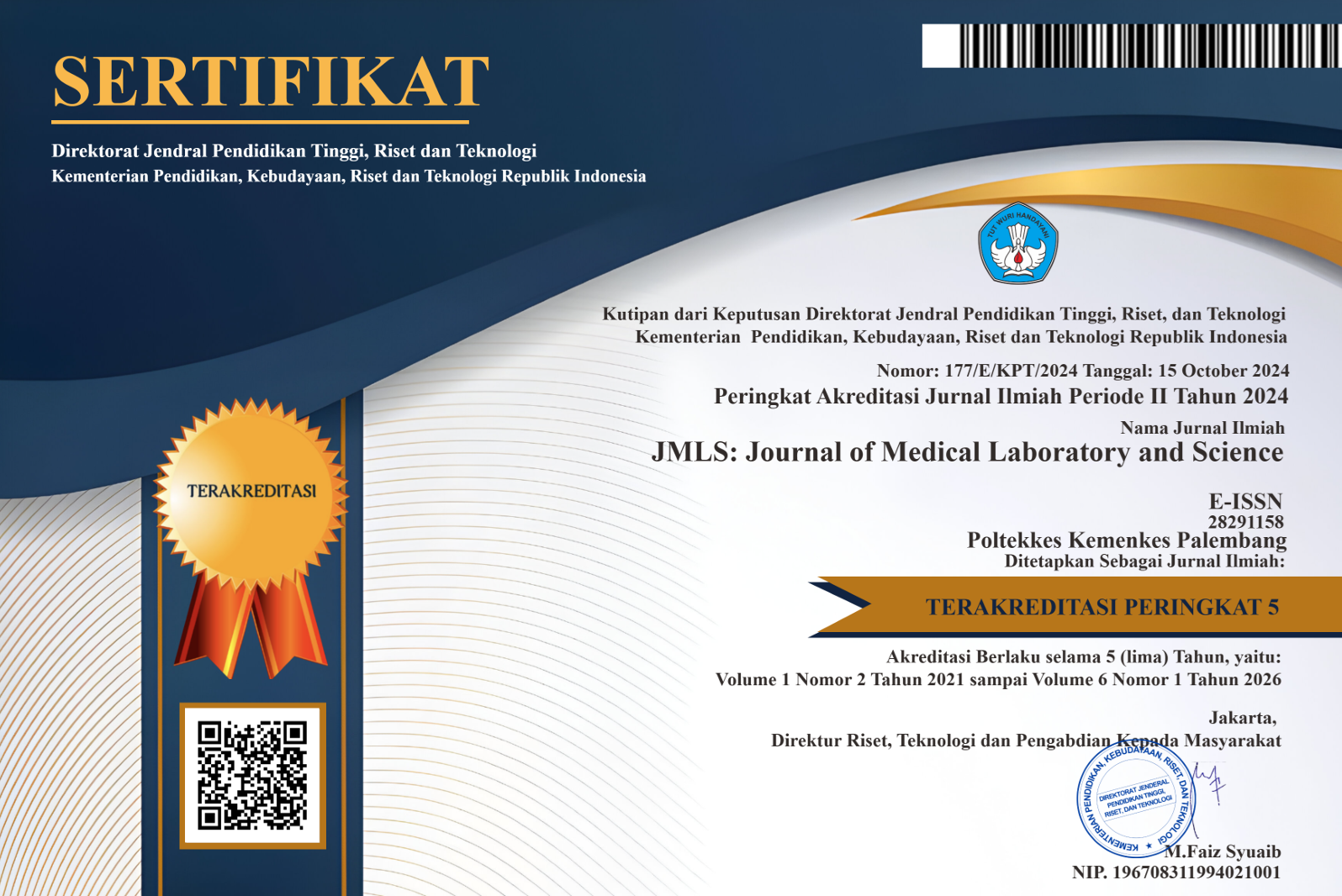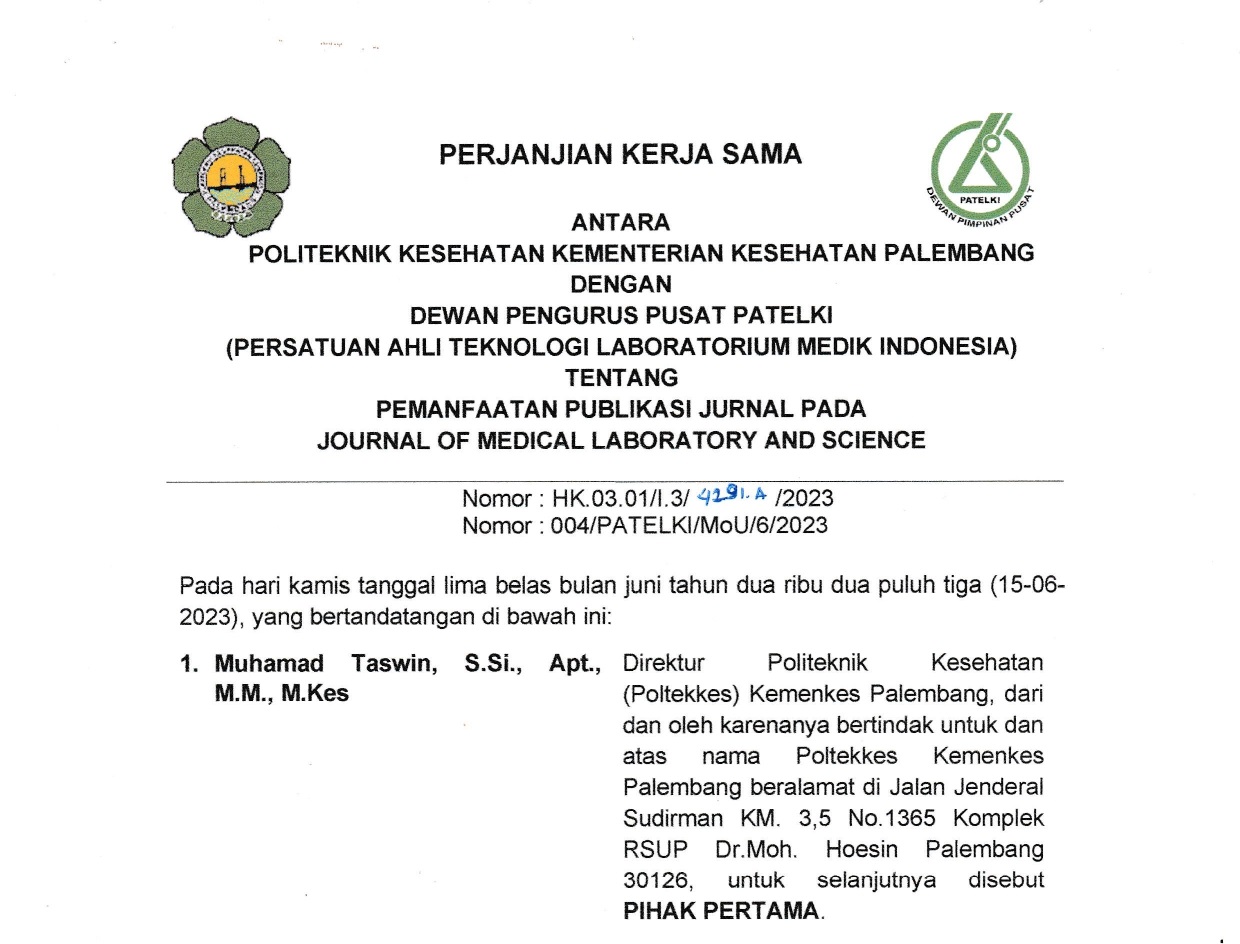FREKUENSI PROTEINURIA PADA PENDERITA LUPUS ERITEMATOSUS SISTEMIK (LES)
Abstract
ABSTRAK
Latar Belakang Lupus Eritematosus Sistemik (LES) merupakan penyakit autoimun multisistem yang mengakibatkan kerusakan organ,jaringan dan sel mediasi karena kompleks imun dan autoantibodi yang berikatan dengan antigen jaringan. LES dapat menyerang satu atau lebih organ, salah satu organ yang banyak diserang adalah ginjal yang dapat menyebabkan komplikasi LES yakni Lupus Nefritis yang memiliki gejala proteinuria. Proteinuria adalah keadaan abnormal dimana jumlah protein dalam urin lebih dari 300 mg dalam urin 24 jam dan 30 mg/dL dalam urin sewaktu. Tujuan penelitian: ini adalah untuk mengetahui frekuensi proteinuria pada penderita Lupus Eritematosus Sistemik (LES) di Palembang tahun 2020, berdasarkan umur, jenis kelamin dan lama sakit. Metode Penelitian: metode penelitian ini adalah deskriptif dengan rancangan cross-sectional. Sampel pemeriksaan yang digunakan adalah urin sewaktu. Jumlah sampel penelitian adalah 29 orang pasien LES di Komunitas PLSS Palembang yang ditentukan dengan teknik purposive sampling. Metode pemeriksaan urin menggunakan metode carik celup (dipstick). Hasil penelitian: menunjukkan sebanyak 6 orang (20.7%) positif proteinuria dan 23 orang (79.3%) negatif proteinuria, Dari 6 orang dengan proteinuria positif, berdasarkan umur ada 6 orang (25.0%) dengan umur berisiko (<50 tahun) dan 0 orang (0.0%) dengan umur tidak berisiko (>50 tahun); berdasarkan jenis kelamin ada 1 orang (50.0%) berjenis kelamin laki-laki dan 5 orang (18.5%) berjenis kelamin perempuan; berdasarkan lama sakit, terdapat 4 orang (57.1%) menderita LES <5 tahun,2 orang (9.1%) menderita LES >5 tahun. Dengan demikian disarankan bagi pasien LES untuk menambahkan pemeriksan fungsi ginjal atau urinalisa pada saat melakukan kontrol rutin.
Kata Kunci : Proteinuria, Lupus Eritematosus Sistemik, Autoimun
ABSTRACT
Background: Systemic Lupus Erythematosus (SLE) is a multisystem autoimmune disease that causes organ, tissue and cell damage due to immune complexes and autoantibodies that bind to tissue antigens. SLE can attack one or more organs, one of the organs that is mostly attacked is the kidney which can cause SLE complications, namely Lupus Nephritis which has symptoms of proteinuria. Proteinuria is an abnormal condition in which the amount of protein in the urine is more than 300 mg in the 24-hour urine and 30 mg/dL in the urine at any time. The purpose of this study: was to determine the frequency of proteinuria in patients with Systemic Lupus Erythematosus (SLE) in Palembang in 2020, based on age, sex and length of illness. Research Methods: This research method is descriptive with a cross-sectional design. The examination sample used was urine at the time. The number of research samples was 29 SLE patients in the Palembang PLSS Community determined by purposive sampling technique. Urine examination method using the dipstick method. The results: showed that 6 people (20.7%) were positive for proteinuria and 23 people (79.3%) were negative for proteinuria. Of the 6 people with positive proteinuria, there were 6 people (25.0%) with age at risk (<50 years) and 0 people. (0.0%) with no risk age (>50 years); based on gender there were 1 person (50.0%) male and 5 (18.5%) female; based on the length of illness, there were 4 people (57.1%) suffering from SLE <5 years, 2 people (9.1%) suffering from SLE >5 years. Thus, it is recommended for SLE patients to add kidney function tests or urinalysis during routine check-ups. Keywords: Proteinuria, Systemic Lupus Erythematosus, Autoimmune
Copyright (c) 2021 Journal of Medical Laboratory and Science

This work is licensed under a Creative Commons Attribution-ShareAlike 4.0 International License.
Authors who publish with this journal agree to the following terms:
- Authors retain copyright and grant the journal right of first publication with the work simultaneously licensed under a Creative Commons Attribution License that allows others to share the work with an acknowledgement of the work's authorship and initial publication in this journal.
- Authors are able to enter into separate, additional contractual arrangements for the non-exclusive distribution of the journal's published version of the work (e.g., post it to an institutional repository or publish it in a book), with an acknowledgement of its initial publication in this journal.
- Authors are permitted and encouraged to post their work online (e.g., in institutional repositories or on their website) prior to and during the submission process, as it can lead to productive exchanges, as well as earlier and greater citation of published work














